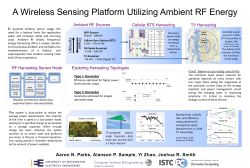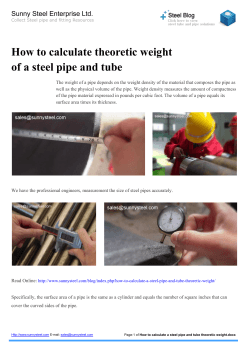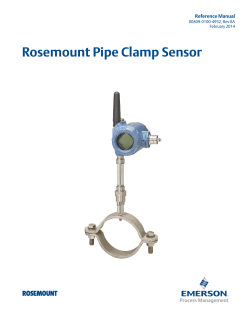
Smart Infrastructure and buildings ‐ why energy harvesting is needed ‐ Kenichi Soga Professor of Civil Engineering
Smart Infrastructure and buildings ‐ why energy harvesting is needed ‐ Kenichi Soga Professor of Civil Engineering Professor of Civil Engineering The Problems The Problems • Poor understanding of performance of infrastructure, during construction and after completion during construction and after completion • Construction industry – Expensive – Old and slow, not always safe – Produces lots of waste • Ageing infrastructure – Typical lifespan in range 15‐60 years – Much of UK infrastructure considerably older The Vision The Vision • Cradle‐to‐grave through whole life cycle dl h h h l lif l • Develop and commercialise p emerging g g technologies – latest sensor technologies latest sensor technologies – data management tools – manufacturing processes manufacturing processes – supply chain management processes – management of the built environment t f th b ilt i t • Interdisciplinary Ageing Engineering Infrastructure Ageing Engineering Infrastructure • Tunnels London Underground (LUL) – Tunnels 75 Tunnels 75 – 100 yrs old 100 yrs old – Deterioration of linings – Minimal clearance to tunnel wall – Risks from 3rd party construction • Water Supply and Sewer Systems Thames Water – 31,000 km of pipelines 31 000 km of pipelines – ½ more than 100 yrs old, 1/3 more than 150 yrs old, ~30% leakage • Bridges Highway Agency/LUL/ Humber Bridge – ~150,000 bridges in UK – Critical links in road/rail infrastructure Critical links in road/rail infrastructure – Deterioration – Many structures below required strength Tunnels Wireless Sensor Network Gateway [Ring1685] Crackmeter [ID8972 Ring1689] Inclinometer [ID8981 Ring1689] Inclinometer [ID8961 Ring1689] Crack. Inc. Inc. Inc. Inc. Inclinometer [ID8921 Ring1689] Relay [ID0021 Ring1700] [ID0021 Ring1700] Relay l Inclinometer [ID00D1 Ring1700] [ID89D1 Ring1689] 168mm F E G H D C B A Wedge segment 19000 rad. J K Inner diameter : 3810 mm Outer diameter : 4146 mm Inner diameter:3810mm Concrete segments Wedge segment L M 115 1 in 10 100 220 1 in 10 N 520 19000 rad. 600 8 Crackmeter (LPDT) LPDT for measurement LPDT for temp. comp. Crack Location Range 12.5mm MicaZ 10 bit ADC Resolution ~12m Crack Inclinometer 2.0dB antenna Main Battery Inclinometer Board Angle Plate Resolution 0.001o Range ±15o External 16 bit ADC Mote Temperature & Humidityy sensor Movement Overview 1640 ~0.006o/month 1661 ~0.020o/month ~0.030o/month Joint ~-0.02mm/month Crack No Change Joint ~0.008mm/month ~0.006o/month No Change 1689 ~0.040o/month 1714 ~0.014o/month Joint 0.020mm/month ~0.015o/month Joint 0.080mm/month ~0 007o/month ~0.007 Crack ~-0.035mm/month ~0.008o/month ~0.015o/month No Change Gateway Inclinometer mote Displacement mote 3.6v battery, y, batteryy capacity: p y 19 Ah ((amp p hour)) 3mins/sample frequency > 500 days. The average power consumption 4.6mW 12 Design of Energy Efficient WSN system Use of relay motes Energy usage:50 Energy Usage :100 Energy usage:50 London WSN case : Inclination Sensor : Environment Sensor : Crack Sensor : Gateway :Relay nodes By placing relay nodes at optimised locations, the battery usage of the motes will be more evenly spread and the life of the Bond Street WSN can be extended for another 30%. Energy harvesting target Laptop 10 W Sensor board Ipod nano Wireless communication MEMS Sensor Electronic Watch 1W 100's mW 5-15 mW 1-10 µW µ 1 µW Target: 1W, 15mW, 1W RF / Sound / Solar energy harvester RF electromagnetic wave power density = 1W/cm2 @ 50 cm distance from the transmitter (WLAN) Sound wave power density = 1W/cm2 @ 100dB sound noise ((10% % traffic pports have such noise level)) Solar cell power density = 100mW/cm2 @ strong sunlight 100W/cm2 @ office Data from London Underground monitoring Air flow velocity in tunnel Wh a train When t i is i passing i (300s-400s) (300 400 ) Tunnel acceleration Tunnel acceleration Air flow speed Air--flow energy harvester power simulation Air Vin Vout Power 1 P AV 3CP 2 Ppeak=0.3mW =0 3mW Time * 10 Fig: Calculated power output using 1cm2 area turbine considering real air flow velocity in tunnels P: power, , ρ: flow density, A: area of turbine, V: flow velocity Cp: power coefficient, (theoretical maximum = 0.593, Betz limit) Train 1 Train 2 4 acceleration: m/s2 acceleration:: m/s 2 4 2 0 -2 -4 0 2 4 6 8 2 0 -2 -4 10 time: s 2 4 6 8 10 time: s 1000 600 Peak Frequency = 278 Hz 400 200 Peak Frequency = 279 Hz 800 spectrum m spectrum m 0 600 400 200 0 0 100 200 300 frequency: Hz 400 500 0 0 100 200 300 frequency: Hz 400 500 Piezoelectric Energy Harvester Variables u: displacement of the mass y: external excitation displacement v: outgoing voltage A (V/N) C (F) D (N/ms) 0.00047 1.27 X 10-7 0.042 Parameters M: mass K: stiffness of the spring D: damper A: piezoelectric coefficient C: piezoelectric capacitance R: resistive load K (N/m) 4320 -3 -7 x 10 3 output power: mW output voltage e: V 1 05 0.5 0 -0.5 -1 1 0 2 4 6 time: s 8 10 x 10 For M = 0.02 g. 2 1 0 0 2 4 6 8 10 time: s 1 uW per kg. Water Mains Water Mains Water Mains monitoring Manhole covers in a UK road. road (Southport) A water pipe inside a manhole. There may be some wireless sensors to measure water flow and pressure. Manhole Cover Vibration Data •Broadband vibration •Multiple frequency peaks: 10-60 Hz and 280-330 Hz (impulse response of the manhole cover) Sinusoidal Excitation based Optimisation 10 Hz 304 Hz 60 Hz F (Hz) M (g) R (KΩ) Power ( / (uJ/Vehicle) ) 304 1 4.1 1 .2 1 0 4 60 30 20.8 6 .4 1 0 3 10 1090 125 0.76 Water Pipe harvester Fluid power generator Fluid velocity Power generator P1 P2 Fluid velocity Power generator P1 P2 Valve Hydraulic power generation using bypass pipes Turbine 1 Main pipe 15 mW Power 85 – 96 Litres/Day v vt 1 rv Main pipe Main pipe v Sys. 1 S 2 Sys. 2 Sys. 3 r 2 0.07 – 0.32 mW < 1 mW Pressure Difference: 63 Pa << 20 KPa Valve 1 2 Water Velocity (m/s) 20.9 – 23.2 0 17 0.27 0.17 – 0 27 0.004 – 0.033 < 1 uW Pressure Diff. (Pa) 350K 63 50 Electric Power 144 – 196 W 0 07 0.32 mW 0.07 – 0 32 W < 1 μW Thermoelectric generation 30 temperatu ure: oC 25 air water Water and air temperature 20 Average Temperature Difference: 3 °C 15 10 Dimension: 40 x 40 x 4.5 mm 5 0 -5 19/10/08 08/12/08 27/01/09 18/03/09 07/05/09 26/06/09 15/08/09 date Costs: 10 USD temperature e difference: oC 15 10 T Temperature diff difference P Power: 2.8 2 8 mW W 5 0 -5 -10 -15 19/10/08 08/12/08 27/01/09 18/03/09 07/05/09 26/06/09 15/08/09 date A 15 mW W System: S 6 Pcs 60 USD Thermoelectric Generator Thermoelectric generation Thermoelectric Generator Outside Air Manhole Chamber V = 20 cm/s V = 2 cm/s Thermal‐Isolated Tube Valve Main pipe Main pipe v System 1 System 2 Power harvesting from water pressure fluctuation g p 380 KPa 370 K D 360 Piston 350 340 Main pipe 20 40 60 80 time: s 100 120 v The Simulated Result of an Optimised p Generator: Piston Area: 1 cm2 M (Kg) 3.7 K (N/m) 17.3 D (Ns/m) 25.2 Power (mW) 3.28 K D Pi t Piston Main pipe v Non‐Resonance Resonance Ave Power = 8 8.1136 1136 mW 30 output po ower: mW output po ower: mW 60 40 20 0 0 20 40 60 80 time: s M (Kg) K (N/m ) D (Ns/m) Resonant 3.60 1.42 Non‐Res 3.60 15.56 20 10 0 100 A e Po Ave Power er = 3.4331 3 4331 mW 0 0.1 Hz Sine Data 20 40 60 80 time: s 100 Recorded Data Ave. Power (mW) P2P Disp (metre) Ave. Power (mW) P2P Disp (metre) 31.83 15.65 0.10 8.11 0.73 22.51 10.83 0.10 3.43 0.13 Per cm2 Bridges Humber Bridge Ferriby Road Bridge (part of Humber Bridge) Bearing Inclination 34 Cracks in Soffit WSN Layout WSN Layout Inclinometers on Bearings 35 Gateway with 12V 100Ah batteryy & Mobile Phone Modem New technologies MEMS resonant power harvester Displacement x3 x1+x2+x3 x2 x1 Frequency f1=1.4kHz, f2=1.8kHz, f3=2.3kHz MEMS power harvester experimental result Current device: Area=0.135cm2, Thickness=25um, gap=2um, f=1.43kHz Power=0.113uW Future work: Area Area=1cm 1cm2, Thickness=400um, gap=10um, f=130Hz Power=2.23uW Yellow: acceleration Green: power output (voltage) EnOcean switches and sensors for buildings Solar cells electromagnetic thermocouples From EnOcean website • seamless built-in technology http://www.dansksolenergi.dk • light shade decreases i incoming i h heat → less A/C usage → environmental friendly • aperture / yield trade-off (similar to LCD trade-off) The Idea S through See th h solar l cells ll • amorphous selenium (a-Se) wide id band b d gap →transparent t t to t visible i ibl light li ht • inexpensive and easy to fabricate thermal evaporation electrolysis Saito et al. (2011) Appl. Phys. Lett. 98, 152102 (2011); doi:10.1063/1.3579262 (3 pages) Large-Scale Deployment Monitor station before, during and after new development Gateway Monitor Flyover in parallel with commercial monitoring system43 Innovation and Knowledge Centre for Smart Infrastructure and Construction Smart Infrastructure and Construction • Develop and commercialise emerging technologies such as latest sensor technologies, data management tools, manufacturing processes, supply chain management processes and management of the built environment. • Starting April 2011 for five years. • £10M from EPSRC/TSB and £7M from Industry / y Construction Sector Infrastructure Sector Manufacturing, Electrical & Information Sectors Summary 1 Summary 1 • Motivation Motivation for infrastructure and building monitoring for infrastructure and building monitoring – Difficult‐to‐access locations – Risk assessment versus monitoring (long‐term monitoring may not be what infrastructure owners want for existing infrastructure) – Minimum disturbance to existing infrastructure g – Newly builds ‐ Construction industry needs to shift to more service oriented industry to more service oriented industry Summary 2 Summary 2 • Cheaper than battery – EH‐Battery combined solution – Batch production (MEMS) – Sensor‐communication electronics integration for Sensor‐communication electronics integration for lower power consumption • Ease of use – Minimum training, off‐the‐shelf solution – Safe, safe and safe , Thank you Acknowledgement , g , y Lobis, Yu Jia, Z. Wong, Ichitaro Saito, , , g, , Jize Yan, Guoliang Ye, Dedy Ken Okano, Yusuke Kobayashi, Ashwin Seshia, James Ransley, Campbell Middleton, Paul Fidler, Neil Hoult, Ian Wassell EPSRC, London Underground, Tubelines, United Utilities, Humber Bridge, Transport for London
© Copyright 2025





















